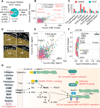Highly multiplexed subcellular RNA sequencing in situ
- PMID: 24578530
- PMCID: PMC4140943
- DOI: 10.1126/science.1250212
Highly multiplexed subcellular RNA sequencing in situ
Abstract
Understanding the spatial organization of gene expression with single-nucleotide resolution requires localizing the sequences of expressed RNA transcripts within a cell in situ. Here, we describe fluorescent in situ RNA sequencing (FISSEQ), in which stably cross-linked complementary DNA (cDNA) amplicons are sequenced within a biological sample. Using 30-base reads from 8102 genes in situ, we examined RNA expression and localization in human primary fibroblasts with a simulated wound-healing assay. FISSEQ is compatible with tissue sections and whole-mount embryos and reduces the limitations of optical resolution and noisy signals on single-molecule detection. Our platform enables massively parallel detection of genetic elements, including gene transcripts and molecular barcodes, and can be used to investigate cellular phenotype, gene regulation, and environment in situ.
Figures




Comment in
-
The big RNA picture.Nat Methods. 2014 May;11(5):471. doi: 10.1038/nmeth.2950. Nat Methods. 2014. PMID: 24820361 No abstract available.
-
RNA sequencing in situ.Nat Biotechnol. 2014 Jun;32(6):543-4. doi: 10.1038/nbt.2921. Nat Biotechnol. 2014. PMID: 24911498 No abstract available.
-
Seeing is believing: new methods for in situ single-cell transcriptomics.Genome Biol. 2014 Mar 31;15(3):110. doi: 10.1186/gb4169. Genome Biol. 2014. PMID: 25000927 Free PMC article.
References
-
- Lecuyer E, et al. Global analysis of mRNA localization reveals a prominent role in organizing cellular architecture and function. Cell. 2007 Oct 5;131:174. - PubMed
-
- Shendure J, et al. Accurate multiplex polony sequencing of an evolved bacterial genome. Science. 2005 Sep 9;309:1728. - PubMed
-
- Kim JB, et al. Polony multiplex analysis of gene expression (PMAGE) in mouse hypertrophic cardiomyopathy. Science. 2007 Jun 8;316:1481. - PubMed
Publication types
MeSH terms
Substances
Associated data
- Actions
- Actions
- Actions
- Actions
Grants and funding
LinkOut - more resources
Full Text Sources
Other Literature Sources
Molecular Biology Databases

